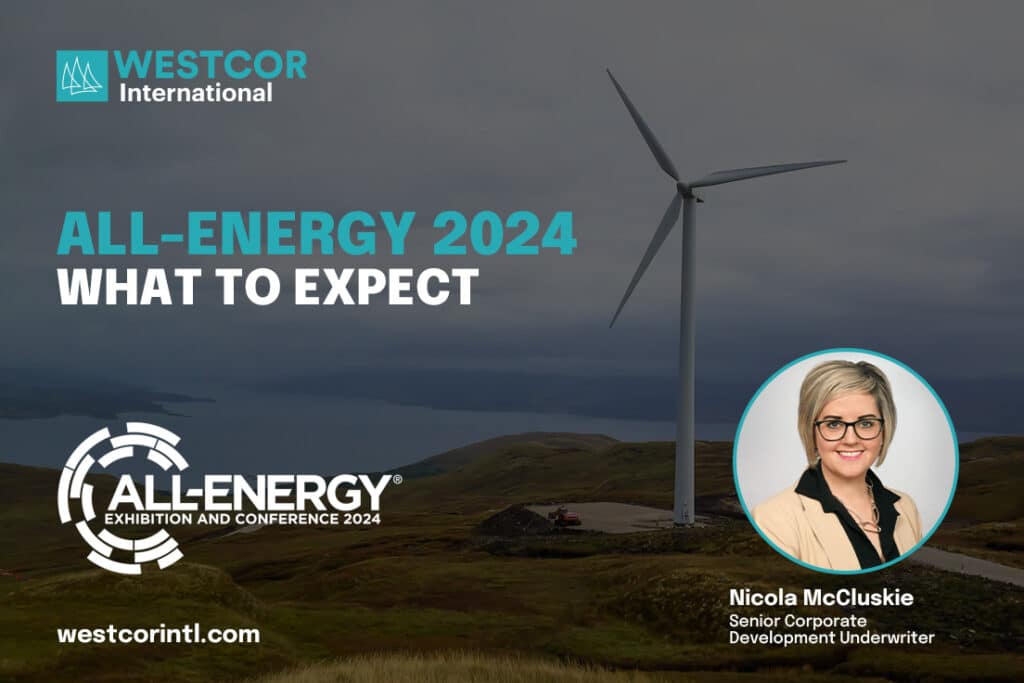All-Energy 2024: What can we expect?
by Nicola McCluskie, Senior Corporate Development Underwriter and Solicitor
As All-Energy rapidly approaches, the anticipation is building for what this year will have in store for the renewables industry in Scotland.
As a recent addition to the Westcor team, and a seasoned renewable energy lawyer, I am looking forward to attending All-Energy on 15th and 16th May. Following in the footsteps of my colleague Kirsty Noble, who provided insightful commentary after last year’s event, I aim to offer a similarly enlightening perspective this year.
One of last year’s main talking points was the Onshore Wind Sector Deal, outlining plans to deliver 20GW of onshore wind in Scotland by 2030. With commitments from both the Scottish Government and the sector, key measures such as biodiversity enhancement, supply chain development, planning improvements, and community investment were highlighted. Nearly seven months post-signing, the question arises: Is Scotland making strides towards the 2030 target?
One specific measure that may draw significant commentary this year is the contrasting approaches taken by Scotland and England and Wales in relation to biodiversity expectations.
While England now mandates a 10% increase in biodiversity value for developers, Scotland lacks a national minimum requirement, focusing instead on biodiversity enhancement. With some English and Welsh authorities surpassing the 10% threshold, the question arises: Will Scotland’s current approach under NPF4 suffice for meeting the ambitious 2030 onshore wind target, or might we see a convergence toward the English system?
Looking beyond the realms of the Onshore Wind Sector Deal, the recent acquisition of the 450MW Red John pumped storage hydro project (now known as “Loch na Cathrach – the “Loch of the Seat”) by Statkraft from Intelligent Land Investments Group highlights the importance of increasing employment and upskilling the workforce within the hydropower sector. This, alongside the Coire Glas development reinforces Scotland’s commitment to capture excess renewable energy and increase the UK’s pumped storage hydro capacity. With significant “untapped” potential in Scotland’s watercourses, what lies ahead for hydro development in the coming year?
On the offshore front, the operationalisation of the Seagreen project signifies progress towards net zero. However, where do Scotland’s offshore aspirations stand?
Hydrogen production is one route that will undoubtedly help with export from offshore wind farms, as well as supporting the electricity system integration through Scotland and beyond. The Stratera Energy Kintore Hydrogen project will be one of the largest developments of its kind and demonstrates to the global energy sector that Scotland is a prime candidate for hydrogen production.
There is much to be positive about in Scotland as we approach mid-2024, although the inevitable hurdles around grid connection dates and infrastructure remain.
From a title insurance perspective, land-related issues, notably oversail concerns, remain pertinent. Title insurance is a tried and tested solution for lenders, developers and landowners for these risks as well as a raft of other issues (e.g. minerals and lack of title) which are synonymous with renewable energy developments, but are developers seeing new trends on the land side and are any of these “blowing in the wind”?
The upcoming event promises insightful discussions from industry experts. I eagerly anticipate gaining further understanding and diverse perspectives on these topics.
Stay tuned for Part 2 of my article, which will follow post-conference. See you at All-Energy!






